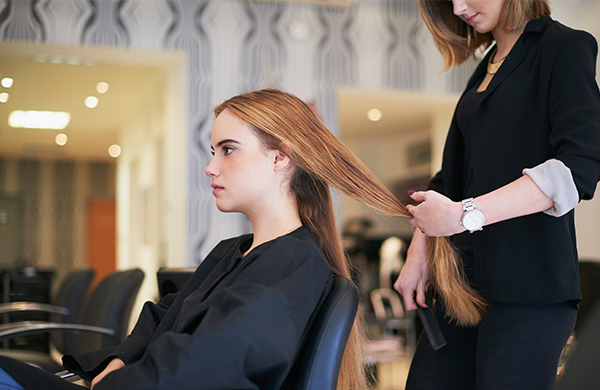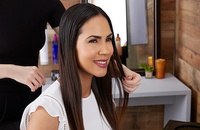
Frizzy hair is a plague on many of our scalps, a curse awakened by humidity and low-quality hairbrushes. Unruly strands have ruined countless 'dos and made women around the globe late for untold get-togethers because they were busy trying to tame the untameable. So what happens when you can't take it anymore?
To help, we created this How to Tame Frizzy Hair Guide covering everything from our favorite hair-taming products, to professional salon services and at-home technique. Consider it your ticket to smoother, silkier strands.
What causes frizzy hair?
Picture a single hair shaft and imagine the outermost layer, the cuticle, as a shingled roof. When the roof is well cared for, the shingles lie flat. When the roof isn't well cared for, the shingles lift in disarray.
This occurs mainly when you don't give your hair enough moisture. The hair seeks out moisture in the air, and the cuticle's shingles lift so the moisture can penetrate into the hair shaft. This also causes the hair shaft to swell. The lifted shingles and swollen shaft create frizz, and explain why a humid day causes more frizz than a dry day.
How to tame frizzy hair at home

Step 1: Wash you hair less
The best thing you can do to fight frizz at home? Shampoo less. Try to stick to shampooing only 2–3 times per week. If your hair is particularly oily, try rinsing well between washes and use dry shampoo when necessary.
Step 2: Use a frizz-taming shampoo
The best shampoos for frizzy hair are free of alcohol and sulfates, which are drying, and high in glycerin, which helps hair retain moisture. Continue to condition with every shower, ideally with a conditioner packed with natural oils and proteins such as keratin.
Step 3: Don't towel dry
Traditional terry-cloth towels pull too much water out of hair, and rubbing damp hair can unsettle the cuticles. Instead, air-dry your hair or opt for a microfiber towel, which quickly converts a mane from dripping-wet to damp. Many curly-haired women swear by the plopping method, in which they wrap damp, product-infused hair in a clean cotton T-shirt for defined, frizz-free spirals. (Some also advocate sleeping on a satin pillowcase or in a silk scarf to help keep hair cuticles smoothed down.)
Step 4: Apply product liberally.

After gently wringing or scrunching excess water out of your just-washed hair, work the anti-frizz serum of your choice through it. Here are a few of our favorites:
Wen Sweet Almond Mint Anti-Frizz Styling Cream ($15.99)

Wen's formula doesn't just help control flyaways—it also creates a protective barrier that helps guard your hair against damage from styling tools. Buy it now.
Frizz Ease Extra Strength Hair Serum ($9.99)

The John Frieda line has long been considered one of the best products for frizzy hair and relies on silk proteins to help smooth the hair shaft. Buy it now.
Frederic Fekkai Brilliant Glossing Cream ($17.31)

This silky, lightweight, olive oil-based formula imbues hair with shine and doubles as a leave-in conditioner. Buy it now.
If your locks are dry but in need of some flyaway control, experts suggest smoothing them down with a touch of conditioner or hair spray applied with a spoolie or fine-tooth comb.
Step 5: Comb, don't brush
Over-brushing can disturb the cuticles, so prioritize detangling over anything else. Sort out damp hair with a wide-tooth comb; tame flyaways and other issues in dry hair by combing through it with wet fingers.
If you must brush, look for one that has boar-bristles, which can help redistribute oils from the scalp throughout the rest of the hair. The Mason Pearson brush (pictured below) is generally considered the Cadillac of boar-hair bristle brushes, but you can find many options at different price points.
Mason Pearson Handy Bristle Brush ($180)

Round brushes may also be used in conjunction with a blow-dryer to style hair so that it looks smooth and silky. Buy it now.
An extreme, direct heat source is no good. To help avoid damage, affix a diffuser to your hair dryer to limit the hot air's forcefulness and concentration. Some hairstylists advocate taking a 90% air-dry, 10% blow-dry approach, focusing the heat on the roots rather than drying out the ends.
Step 7: Lower the heat
Limit your use of straighteners and curling wands, and lower their temperature when you do use them. High heat settings can cook your hair, swelling the strands as they struggle to get moisture in. Although you might think you're smoothing your hair with that extra-hot flat iron, you're really inviting frizz to make itself at home.

The best frizz-taming salon treatments
You could do a DIY hair mask at home to repair damaged, frizzy hair with coconut oil or olive oil. Almost every salon, however, offers deep-conditioning treatments using professional-quality products, which combine powerful natural oils with other active ingredients. (You're also probably going to let the conditioner set properly when you're being monitored by someone else.) The treatment helps seal the cuticle against puff-ifying outside moisture, and the benefits are meant to last.
Keratin-based formulas such as Brazilian Blowout or Keratin Complex can help smooth the hair for months at a time with proper after-care. The protein coats each strand, sealing gaps and producing a smooth cuticle layer. The stylist sets the solution with heat from a flat iron. Because the straightening treatments involve chemicals and heat, though, they require nominally healthy hair. If your hair is eternally frizzy, you may have to rehabilitate it or cut it off first. A stylist can tell you what's what.
The effects of thermal reconditioning, also known as Japanese straightening, generally last until your hair grows out or you cut it off. The process is similar to a keratin-smoothing treatment, except with an additional step and a formula that's perhaps more chemically potent. The hallmarks of thermal reconditioning are smooth, de-texturized locks with a noticeable shine. Both semi permanent and permanent services, however, must be maintained with the same at-home care methods detailed above.
RELATED READS:









